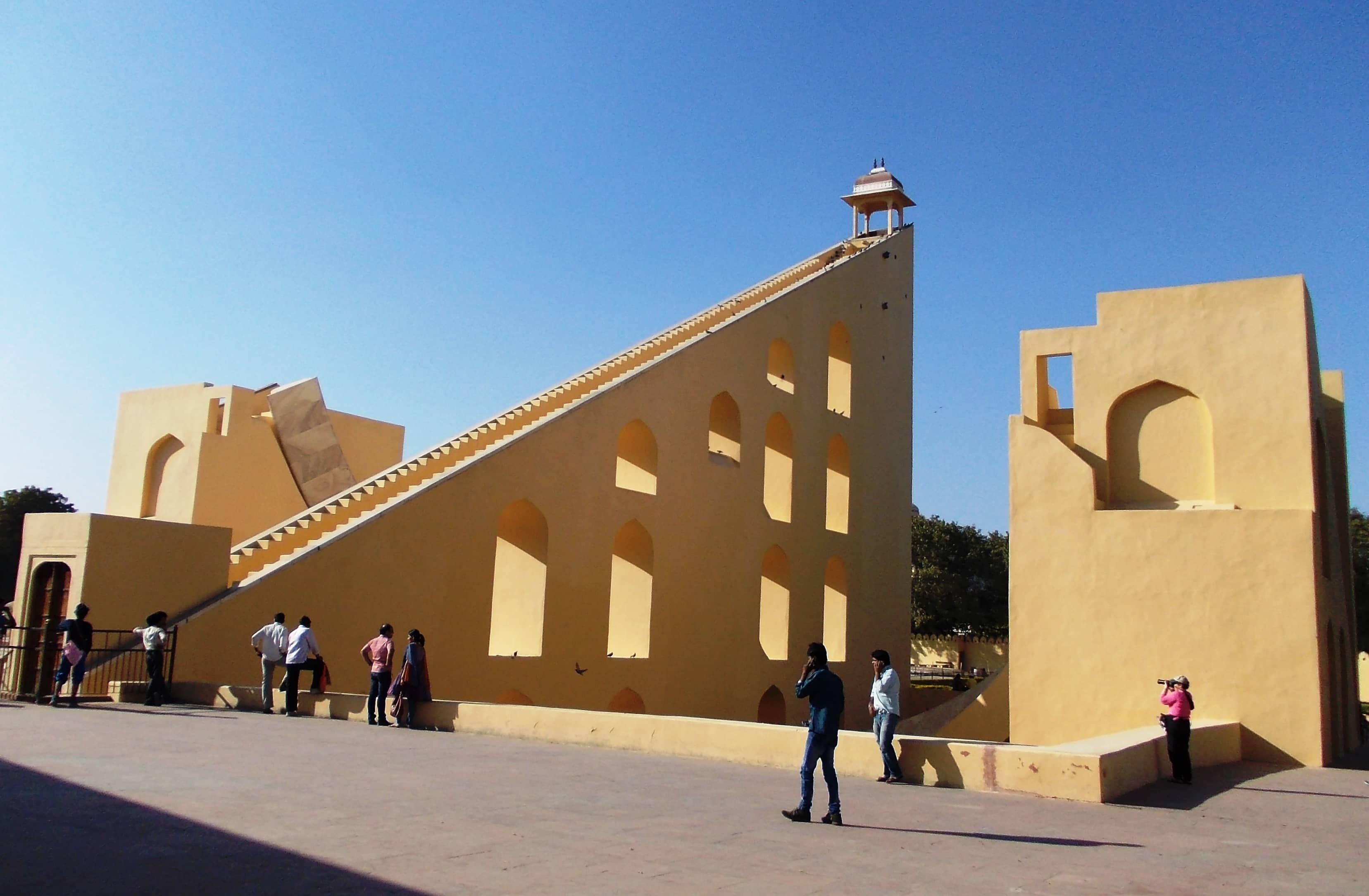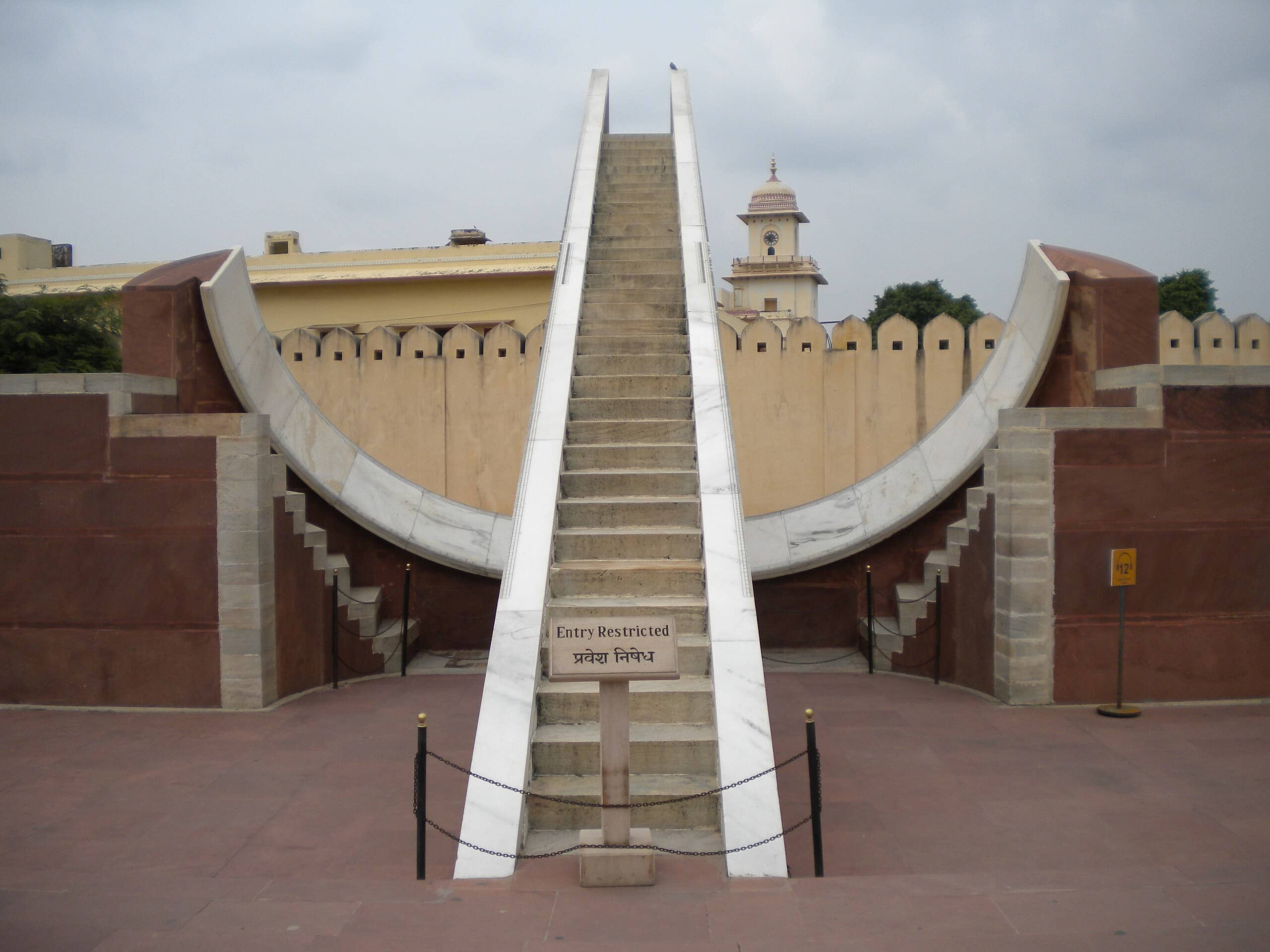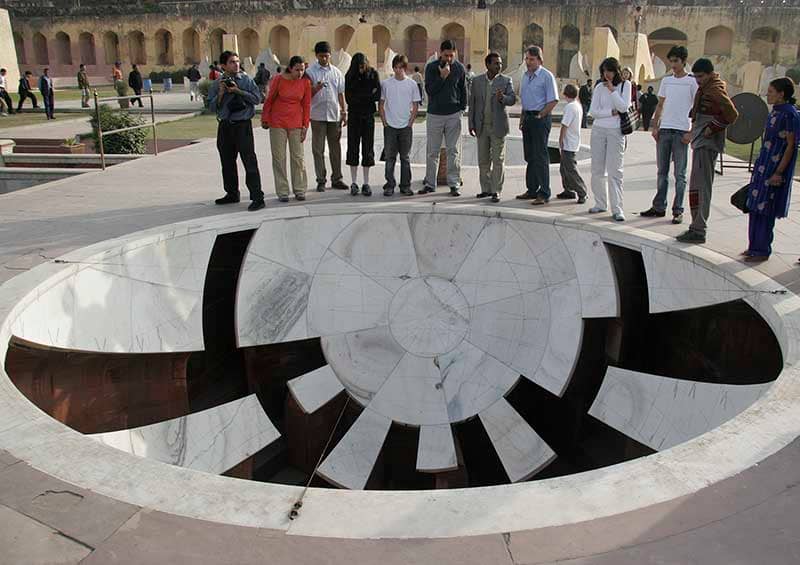
Jantar Mantar Jaipur
An 18th-century astronomical observatory, Jantar Mantar Jaipur is a UNESCO World Heritage Site featuring colossal stone instruments for celestial obse...

Highlights
Must-see attractions

Social
From TikTok & Reddit
Best Time
Instruments work best

Jantar Mantar Jaipur
Best Time
Instruments work best

Highlights
Must-see attractions
An 18th-century astronomical observatory, Jantar Mantar Jaipur is a UNESCO World Heritage Site featuring colossal stone instruments for celestial observation.
"Jantar Mantar isn’t just a monument—it’s a living classroom and a sculptural wonder."

Hire a Knowledgeable Guide
Enhance your understanding of the ancient astronomical instruments and their functions. :bustsinsilhouette:
Watch the Intro Video
A short, fascinating video explains the history and purpose of the observatory. :movie_camera:

Highlights
Discover the most iconic attractions and experiences

Samrat Yantra
Central Courtyard
The world's largest stone sundial, a marvel of ancient engineering that still accurately tells time.

Laghu Samrat Yantra
Near Samrat Yantra
A smaller, yet equally precise, sundial offering a fascinating glimpse into timekeeping.

Jai Prakash Yantra
Hemispherical Depressions
A unique instrument that uses shadows cast on a concave surface to map celestial positions.
Plans like a pro.
Thinks like you
Planning Your Visit
Timing is Everything
Unlock the Secrets
Best Times
Insider Tips
from TikTok, Instagram & Reddit
Jantar Mantar is a 300 year old architectural marvel that is still astonishing yet astounding!
Hire a Knowledgeable Guide
Enhance your understanding of the ancient astronomical instruments and their functions. :bustsinsilhouette:
Watch the Intro Video
A short, fascinating video explains the history and purpose of the observatory. :movie_camera:
Travelling to Jaipur for three days, what all do you think I can visit/eat/do ?
Wear Comfortable Shoes
You'll be doing a lot of walking around the vast site. :athletic_shoe:
Visit on a Sunny Day
The instruments are best observed and understood when the sun is out. :sunny:
Tips
from all over the internet
Hire a Knowledgeable Guide
Enhance your understanding of the ancient astronomical instruments and their functions. :bustsinsilhouette:
Watch the Intro Video
A short, fascinating video explains the history and purpose of the observatory. :movie_camera:
Wear Comfortable Shoes
You'll be doing a lot of walking around the vast site. :athletic_shoe:
Visit on a Sunny Day
The instruments are best observed and understood when the sun is out. :sunny:
Photography Opportunities
The unique architecture and instruments make for stunning photos, especially during golden hour. :camerawithflash:
What Travellers Say
Reviews Summary
Visitors consistently praise Jantar Mantar Jaipur as an architectural marvel and a fascinating educational experience, highlighting its unique astronomical instruments and historical significance. While some note crowds, the consensus is that it's a must-visit for its blend of science, art, and history, especially with a good guide.
"Jantar Mantar isn’t just a monument—it’s a living classroom and a sculptural wonder. Perfect for history buffs, science enthusiasts, photographers, or anyone curious about how ancient minds blended function and form. Whether you walk through it under the sun or catch the evening show, it’s a standout experience that captures the cosmic curiosity of Jaipur."
Hirali Sanghani
"My visit to the Jantar Mantar observatory in Jaipur was scheduled for a public holiday, and as expected, the place was bustling with a huge number of tourists.
One of the highlights of my visit was a short, ten-minute introductory video that was shown inside. It provided a concise and fascinating explanation of the history and purpose. It was a great way to understand the complex design of the instruments and the genius of Maharaja."
pallavi gayathri
"For an Engineer like me it was one of the best places to explore and discover ancient methods of knowledge and experience the observatory with tools dating back to 200+ years. Though I visited on a rainy day but it would really describe it's working on a Sunny day. I did not take any guide for it because I wanted to explore the tools and it's working myself and I would suggest the same if you wish to learn more about it."
Shishir Sharma
What People Like
What People Dislike
Frequently Asked Questions
🚇 🗺️ Getting There
Jantar Mantar Jaipur is centrally located in the city, near the City Palace. You can easily reach it by auto-rickshaw, taxi, or ride-sharing services from anywhere in Jaipur. It's a popular stop on most city tours, making it accessible for tourists exploring the 'jaipur observatory'.
Auto-rickshaws and taxis are readily available and convenient for reaching Jantar Mantar Jaipur. Many visitors combine their visit with the nearby City Palace, so planning a route that covers both is efficient.
While direct bus routes might be less common for tourists, auto-rickshaws and taxis are abundant and affordable, serving as effective public transport options to reach the 'jantar mantar observatory in jaipur'.
Jantar Mantar Jaipur is located in the heart of the Pink City, adjacent to the City Palace and Hawa Mahal, at the address: Gangori Bazaar, J.D.A. Market, Pink City, Jaipur, Rajasthan 302002, India. Its central 'jaipur jantar mantar location' makes it easy to find.
Yes, there are numerous 'hotel near Jantar Mantar Jaipur' options, ranging from budget guesthouses to luxury hotels, especially in the Pink City area. Booking in advance is recommended, particularly during peak tourist seasons.
🎫 🎫 Tickets & Entry
The 'Jantar Mantar Jaipur ticket price' varies for Indian citizens and foreign nationals. As of recent information, Indian adult tickets are typically around ₹50, while foreign national tickets are around ₹200. It's always best to check the official website or ticket counter for the most current 'jantar mantar ticket price'.
You can purchase 'Jantar Mantar Jaipur tickets' at the on-site ticket counter. For convenience, some sources suggest looking for 'Jantar Mantar Jaipur online ticket' options, though availability can vary. Checking for 'Jantar Mantar Jaipur ticket online booking' is advisable.
The 'Jantar Mantar Jaipur opening time' is generally from 9:00 AM to 5:00 PM daily. However, it's crucial to confirm the exact 'Jantar Mantar Jaipur timings' as they can sometimes be subject to change. The 'timing of Jantar Mantar Jaipur' is consistent throughout the week.
While not always mandatory, booking 'Jantar Mantar Jaipur tickets online' or in advance can save you time, especially during peak seasons or holidays when the 'Jantar Mantar observatory Jaipur' can get crowded. Look for 'Jantar Mantar Jaipur online ticket booking' options.
Sometimes, combined tickets are available that include entry to Jantar Mantar Jaipur along with other nearby attractions like the City Palace. Inquiring at the ticket counter or checking official tourism websites can provide details on such packages.
🎫 🧭 Onsite Experience
Jantar Mantar Jaipur features nineteen major astronomical instruments, including the Samrat Yantra (the world's largest sundial), Jai Prakash Yantra, and Laghu Samrat Yantra. These 'Jantar Mantar Jaipur instruments' are designed for observing celestial positions with the naked eye.
While you can explore independently, a guide can greatly enhance your understanding of the complex 'Jantar Mantar Jaipur instruments' and their astronomical functions. Many visitors recommend hiring a guide for a richer experience, as noted in 'Jantar Mantar Jaipur guide' searches.
The 'best time to visit Jantar Mantar Jaipur' for photography is during the early morning or late afternoon when the light is softer and creates beautiful shadows, highlighting the unique 'Jantar Mantar Jaipur architecture'. 'Jantar Mantar Jaipur photos' are particularly striking during the golden hours.
Yes, Jantar Mantar Jaipur is recognized as a 'Jantar Mantar Jaipur UNESCO World Heritage Site' for its outstanding universal value and its representation of the astronomical traditions of India.
You can learn about ancient Indian astronomy, timekeeping, and the sophisticated architectural and scientific knowledge of the 18th century. The site serves as a 'living classroom' for understanding celestial mechanics and the history of science.
🍽️ 🍽️ Food & Dining
There are no food or dining facilities directly inside Jantar Mantar Jaipur. However, numerous restaurants, cafes, and street food vendors are located in the surrounding Gangori Bazaar and Pink City area, offering a wide range of Rajasthani and Indian cuisine.
You can find a variety of local Rajasthani delicacies, Indian curries, snacks, and sweets in the vicinity. Popular options include Dal Baati Churma, Laal Maas, and various chaats. Many eateries cater to both local tastes and tourist preferences.
Generally, it's advisable to consume food and drinks outside the monument premises to maintain its cleanliness and heritage status. Water bottles are usually permitted, but it's best to check specific rules upon entry.
📸 📸 Photography
Yes, photography is generally allowed inside Jantar Mantar Jaipur. However, tripods and professional video recording equipment might require special permission or incur additional fees. Capturing 'Jantar Mantar Jaipur photos' is a popular activity.
The Samrat Yantra, the various geometric structures, and the interplay of light and shadow on the instruments offer excellent photographic opportunities. The unique 'Jantar Mantar Jaipur architecture' provides a dramatic backdrop.
While general photography is permitted, avoid using flash photography that might disturb other visitors or potentially damage delicate surfaces over time. Always be mindful of your surroundings and respect the heritage site.
Drone photography is typically prohibited at historical monuments and heritage sites like Jantar Mantar Jaipur due to security and preservation concerns. It's best to rely on ground-level photography for your 'Jantar Mantar Jaipur photos'.
For Different Travelers
Tailored advice for your travel style
👨👩👧 Families with Kids
👩🎓 Science Enthusiasts & History Buffs
📸 Photographers
Deep Dives
In-depth insights and expert knowledge
The Genius of Maharaja Sawai Jai Singh II
His vision was to create instruments that could measure time, predict eclipses, and track stars and planets. Unlike contemporary observatories that relied on smaller, portable instruments, Jai Singh II opted for colossal, fixed structures made of stone and masonry. This allowed for unprecedented precision in astronomical observations. The 'Jantar Mantar Jaipur information' available on-site often highlights his dedication to this monumental scientific endeavor, blending art, architecture, and astronomy seamlessly.
The 'Jantar Mantar Jaipur made by' skilled artisans and architects under his direct supervision, incorporating principles from various astronomical traditions, including Hindu, Islamic, and European methods. This fusion of knowledge resulted in a unique and highly functional observatory that continues to fascinate scientists and visitors alike, showcasing the intellectual prowess of 18th-century India.
Understanding the Astronomical Instruments
These instruments were not merely decorative; they were functional tools for astronomical calculations. For instance, the Laghu Samrat Yantra is a smaller version of the main sundial, offering a more accessible way to understand timekeeping. The Nariyal Yantra is used to measure zenith distance, while the Raj Yantra is a meridian line instrument. The sheer ingenuity behind these 'Jantar Mantar Jaipur instruments' allows for the observation of astronomical positions with the naked eye, a feat that underscores the advanced scientific understanding of the era.
Visitors can explore these fascinating structures, and many find that understanding their purpose significantly enhances their visit. The 'Jantar Mantar Jaipur sundial' is a prime example of how these instruments were used for practical applications, from determining auspicious times for events to predicting weather patterns. The site truly functions as an 'observatory in Jaipur' that educates and inspires.
Jantar Mantar Jaipur: A UNESCO World Heritage Site
The UNESCO recognition underscores the importance of preserving this remarkable monument for future generations. It acknowledges the scientific and architectural brilliance that went into its creation, blending traditional Indian astronomical knowledge with contemporary scientific advancements. The 'Jantar Mantar Jaipur UNESCO' status draws global attention to its historical and scientific importance.
As a 'Jantar Mantar Jaipur world heritage site', it attracts scholars, astronomers, architects, and tourists from around the globe, all eager to witness firsthand the legacy of ancient Indian science and the enduring power of human curiosity about the cosmos.




Social
from TikTok, Instagram & Reddit